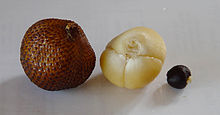Calamoideae
| Calamoideae | ||||||||||||
|---|---|---|---|---|---|---|---|---|---|---|---|---|

|
||||||||||||
| Systematics | ||||||||||||
|
||||||||||||
| Scientific name | ||||||||||||
| Calamoideae | ||||||||||||
| Handle. |
The Calamoideae are a subfamily of the palm family (Arecaceae). They are considered the most original subfamily, comprise around a quarter of all palm species and, with the Calamus, by far the most species-rich genus. A distinctive feature of the representatives are the overlapping scales on fruits and ovaries.
features
The representatives can be hermaphroditic, monoecious , dioecious or polygamous palms. They are single (hapaxanth) or multiple flowering ( pollakanth ). They are often heavily reinforced. The leaves are pinnate, pinnate, or rarely fan-shaped. The inflorescences are often heavily branched. The bracts are mostly Roehrig. The flowers are almost always in dyads (in pairs) or derivatives thereof. Single-sex flowers are designed only slightly differently. Ovary and fruit are covered with scales, which are usually in vertical rows. The ovary is incompletely divided into three compartments. The ovules are anatropic, their micropyle points to the center of the ovary . The pericarp is thin when the fruit is ripe, an endocarp is not differentiated (except in Eugeissona ). One to three seeds develop in a fruit, which usually have a thick sarcotesta .

distribution
Four genera occur in the tropics of the New World ( Neotropis ): Mauritia , Mauritiella , Lepidocaryum and Raphia . The rest are native to the tropics of the Old World (Africa, Asia, Australia). The highest biodiversity is found in Malesia and neighboring areas of Southeast Asia.
Systematics
The Calamoideae as defined by Dransfield et al. (2008) are identified as natural relatives ( monophyletic ) in practically all studies . In most of the works they are the sister group of all other palm trees. They see some works as sister groups of all palm trees with the exception of Nypa .
Within the subfamily, three tribes are distinguished, the relationship of which is as follows:
|
|
|
||||||||||||
|
|
For a list of all genera, see palm trees .
Web links
supporting documents
- John Dransfield, Natalie W. Uhl, Conny B. Asmussen, William J. Baker, Madeline M. Harley, Carl E. Lewis: Genera Palmarum. The Evolution and Classification of Palms . Second edition, Royal Botanic Gardens, Kew 2008, ISBN 978-1-84246-182-2 , p. 141.